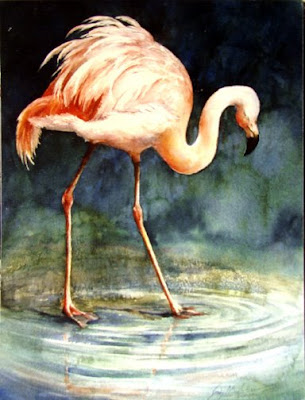 Rhonda Carpenter's newest paintings of flamingos shows how well she incorporates various hot colors to define the birds - see her blog here. Many, many, many moons ago, I painted this fancy flamingo as a class demo to show how to achieve the look of feathers as well as how to make the most of contrast.
Rhonda Carpenter's newest paintings of flamingos shows how well she incorporates various hot colors to define the birds - see her blog here. Many, many, many moons ago, I painted this fancy flamingo as a class demo to show how to achieve the look of feathers as well as how to make the most of contrast. Planning ahead to allow the darkest darks to be next to the lightest lights in a painting is one of the easiest ways to make a stronger focal point to draw the eye. Hard edges also get the most attention - compared to soft or lost edges, as do diagonal lines, compared to horizontal or vertical ones.
Small shapes make the eye stop and look. Strong color temperature change - warm vs. cool - is another effective tool to incorporate in the focal area. Even using pure colors next to slightly grayed ones makes the pure color get much more attention.
Any type of contrast always makes us notice and keeps our interest. It's fun to take advantage of that principle to make a painting more effective, more exciting for the viewer to look at.
"STRUTTING HER STUFF" Transparent Watercolor on 140#CP Arches 13 x 20" COLLECTED



8 comments:
The contrast really perks this one up, Sandy :) There is another artist doing flamingos right now (on my sidebar blogroll) but she's going slowly slowly and pale colors. I don't seem to be able to paint them that way.
It's very striking thanks to all those contrasts you mention! What you say and what you said the other day (the old rose) is very interesting.
Sandy, I love your flamingo and especially the wonderful background which is so authentic and the cool colors really compliment the flamingo. (or should I say "complement?" :)
Barb
You really paint a wide variety of subjects so well. Love this one and appeciate all of the info you share.
I found this post and your previous post particularly enlightening. Thanks for generously sharing your wisdom on design. I like where you've placed the focal point in this painting. It's interesting!
Hi Sandy, Thanks for all of the focus info. I am going to print it and read before I begin a painting.
Wow Sandy, this is beautiful! I love the contrast of the background and the feathers. I really do love your style of painting.
Thanks so much for leaving your appreciated comments. I hope your week is full of lots of painting time, too.
Post a Comment